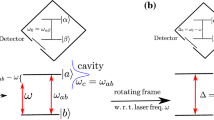Abstract
The Keldysh nonequilibrium diagram technique is presented in a form suitable for calculating the nonlinear optical response of elementary quantum systems. It is shown that the integral equation arising in the diagram technique for two-temporal static Green functionF(t,t′) =G rΩG α is equivalent to a system of three equations one of which is the kinetic equation for the functionF at coinciding times, while the other two are necessary for calculating the collision integral in the first equation. These equations make it possible to expressF(t, t′) via its value for coinciding times at a time moment that corresponds to the minimum value of timest andt′ and is written separately fort>t′ andt<t′. Joint solution of these three equations always leads to a kinetic equation of the non-Markovian type. Equations that make it possible to apply the diagram technique for description of relaxation of the initial nonequilibrium distribution at the kinetic stage of evolution are given as well.
A general formal approach is also used for solving problems in which the effects of non-Markovian relaxation of quantum systems in light fields are important. Problems of the effect of a weak electromagnetic field on the relaxation process in multilevel systems and a strong resonant field in a two-level system are considered. A new method for calculating the spectral distribution of resonance fluorescence is derived.
Similar content being viewed by others
References
P. A. Apanasevich,Principles of Interaction of Light with Matter [in Russian], Nauka i Tekhnika, Minsk (1977).
P. N. Argyres and P. L. Kelly,Phys. Rev. A,134, 98 (1964).
É. G. Pestov,Zh. Éksp. Teor. Fiz.,86, 1643 (1984).
A. G. Zhidkov,Zh. Éksp. Teor. Fiz.,88, 372 (1985).
Y. Rabin, D. Grimbert, and S. Mukamel,Phys. Rev. A,26, 271 (1982).
S. Mukamel,Phys. Rept.,93, 1 (1982).
S. Mukamel, D. Grimbert, and Y. Babin,Phys. Rev. A,26, 341 (1982).
É. G. Pestov,Kvantov. Électron.,44, 1031 (1987).
Z. Deng,J. Phys. B,18, 2387 (1985).
Z. Deng and S. Mukamel,Phys. Rev. A,29, 1914 (1984).
E. Hanamura,J. Phys. Soc. Japan,52, 3265 (1983).
B. A. Grishanin,Zh. Éksp. Teor. Fiz.,85, 447 (1983).
M. Aihara,Phys. Rev. B,27, 5904 (1983).
S. Mukamel,Phys. Rev. A,28, 3480 (1983).
E. Hanamura,J. Phys. Soc. Japan,52, 3678 (1983).
J. H. Eberly and M. Yamanoi,Phys. Rev. Lett.,52, 1353 (1984).
R. G. Brewer and R. G. DeVoe,Phys. Rev. Lett.,52, 1354 (1984).
A. Schenzle, M. Mitsunaga, R. G. DeVoe, and R. G. Brewer,Phys. Rev. A,30, 325 (1984).
M. Yamanoi and J. H. Eberly,J. Opt. Soc. Amer. B,1, 751 (1984).
E. Wodkiewicz and J. H. Eberly,Phys. Rev. A,32, 992 (1985).
P. R. Berman and R. G. Brewer,Phys. Rev. A,32, 2784 (1985).
P. A. Apanasevich, S. Ya. Kilin, A. P. Nizovtsev, and N. S. Onishchenko,Opt. Commun.,52, 279 (1984).
P. A. Apanasevich, S. Ya. Kilin, A. P. Nizovtsev, and N. S. Onishchenko,J. Opt. Soc. Amer. B,3, 587 (1986).
P. R. Berman,J. Opt. Soc. Amer. B,3, 564 (1986).
M. Yamanoi and J. H. Eberly,Phys. Rev. A,34, 1009 (1986).
R. G. DeVoe and R. G. Brewer,Phys. Rev. Lett.,50, 1269 (1983).
L. V. Keldysh,Zh. Éksp. Teor. Fiz.,47, 1515 (1964).
M. Lax,Fluctuations and Coherent Phenomena in Classical and Quantum Physics, in Series: M. Cretien, E. P. Gross, and S. Deser (eds.),Statistical Physics, Phase Transitions and Superconductivity, Gordon and Breach, New York (1968).
A. A. Abrikosov, L. P. Gor'kov, and I. E. Dzyaloshinskii,Methods of Quantum Field Theory in Statistical Physics [in Russian], Fizmatgiz, Moscow (1962).
An. V. Vinogradov, “Two types of nonlinear optical susceptibilities” [in Russian],Preprint of the Lebedev Physical Institute, No. 42, Moscow (1984).
Yu. A. Kukharenko and S. G. Tikhodeev,Zh. Éksp. Teor. Fiz.,83, 1444 (1982).
An. V. Vinogradov,Kvantov. Électron.,13, 293 (1986).
A. G. Hall,J. Phys. A,8, 214 (1975).
A. G. Hall,Physica A,80, 369 (1975).
E. M. Épshtein,Fiz. Tverd. Tela,11, 27 (1969).
R. Pantel and G. Puthov,Fundamentals of Quantum Electronics, Wiley, New York (1969).
V. M. Fain,Photons and Nonlinear Media [in Russian], Sov. Radio, Moscow (1972).
S. S. Fanchenko,Zh. Éksp. Teor. Fiz.,85, 1936 (1983).
É. G. Pestov,Kvantov. Électron.,13, 247 (1986).
A. G. Redfield,Phys. Rev.,98, 1787 (1955).
R. G. Brewer and E. L. Khan,Sci. Amer.,251, 4 (1984).
T. Endo, T. Muramoto, and T. Haski,Opt. Commun.,52, 403 (1984).
An. V. Vinogradov, “Field action on relaxation processes in multilevel systems and high nonlinear optic susceptibilities,” Report at the Fifth Intern. Conference “Lasers and their applications,” Dresden (1985).
A. A. Abrikosov and L. P. Gor'kov,Zh. Éksp. Teor Fiz.,39, 1781 (1960).
A. I. Burshtein,Zh. Éksp. Teor. Fiz.,49, 1362 (1965).
A. I. Burshtein,Zh. Éksp. Teor. Fiz.,48, 850 (1965).
D. A. Hutchinson,Canad. J. Phys.,63, 139 (1985).
B. A. Mollow,Phys. Rev. A,15, 1023 (1977).
P. L. Knight and P. W. Miloni,Phys. Repts.,66, 21 (1980).
A. Burnet,Phys. Repts.,118, 339 (1985).
Author information
Authors and Affiliations
Additional information
Translated from Trudy Fizicheskogo Instituta im. P. N. Lebedeva (Proceedings of the Lebedev Physical Institute, Russian Academy of Sciences, Moscow), Vol. 187, pp. 117–143, 1988.
Rights and permissions
About this article
Cite this article
Vinogradov, A.V. Application of the nonequilibrium diagram technique to strongly driven atomic systems. J Russ Laser Res 17, 551–578 (1996). https://doi.org/10.1007/BF02069173
Issue Date:
DOI: https://doi.org/10.1007/BF02069173




